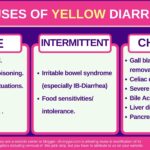9 Causes of Lighter-Colored Poop & When to Worry.
Our content is not intended nor recommended as a substitute for medical advice by your doctor. Use for informational purposes only.
Lighter-colored poop is a frequent finding by many people. Most cases are often due to simple causes such as:
- Eating yellow foods or food pigments.
- Speeding up of intestinal contents (diarrhea, loose stool).
- Indigestion of a large fatty meal.
Less commonly, Lighter-colored poop reflects a medical problem. Very light-colored poop (also called clay or pale stool) can be a sign of diseases such as:
- Diarrhea for any cause (infection, food intolerance, or malabsorption).
- Liver and gallbladder diseases (due to the deficiency or absence of bile which gives the stool its standard brown color).
- Fat malabsorption, as with Chronic pancreatitis, bile obstruction, celiac disease, and other malabsorption syndromes.
- Certain infections, such as giardiasis (lead to fat malabsorption).
- Medication overuse (leading to diarrhea): as with laxative overuse and metformin.
We help you explore both the simple and serious causes of Lighter-colored poop. Also, we will help you to decide when and when not to worry.
Legal notice:
This article was written and published by www.oh-mygut.com. Republishing this content without written permission from the owner is considered content theft. Copyrights Reserved.
1. Foods that cause lighter-colored poop.
All shades of brown poop are normal as long as you don’t have any other digestive symptoms
The type and the amount of food you eat affect your poop color. Occasional lighter-colored one or two bowel motions are considered normal.
Light brown poop with no other symptoms (abdominal pain, diarrhea, bloating, etc.) is often a result of your foods.
Common foods that cause lighter-colored stool:
- Carrots.
- Sweet Potatoes.
- High-fat foods.
- Tumeric
- Butter.
- Corn.
- Banans.
- Pineapple.
- Yellow rice.
- And others.
The complete list of yellow-colored foods is here.
The amount you eat matters.
The amount you eat yellow food plays a role in the degree of change in your poop color.
Eating smaller amounts will not do much of a change in your standard brown poop color.
The more you eat yellow foods, The lighter your poop color gets.
And this may explain why you don’t experience lighter-colored stool every time you eat one of the above foods.
How to know food is the cause of lighter-colored stools?
- History of taking a significant amount of yellow food before the lighter-colored poop.
- There are no other digestive system symptoms (abdominal pain, diarrhea, nausea, etc.).
- The stool color reverts to its standard brown color shortly.
2. Food intolerance and allergy.
Food intolerance is difficulty digesting certain types of food or food constituents.
As a result, food Stays unchanged (undigested) inside the gut tract. As a result, symptoms appear, such as bloating, abdominal pain, diarrhea (or loose stool), and others.
The main reason food intolerance causes lighter-colored food is the speeding up of intestine contents to eliminate unwanted foods accumulating in your digestive system.
Also, Foods that are not adequately digested draw more water into the small and large intestines, changing the stool composition.
More water in poop makes the poop lighter in color, looser, or watery.
Food intolerance is widespread; at least one in every five individuals (20%) has a food intolerance, and most don’t know.
Common types of food intolerance.
1. Lactose intolerance:
The most common form of food intolerance is lactose intolerance. An average of 65% of adults have lactose intolerance (reference). Lactose is the chief sugar in milk and other dairy products.
2. Fructose intolerance.
Fructose is the chief sugar in most fruits and honey. As a result, many people will get loose stool or have diarrhea after ingesting too much fructose.
Typically, About 75% of adults will get diarrhea (with lighter-colored poop) when they ingest excess fructose (40 to 80 grams of fructose (reference).
3. Fat.
Fat can cause light or yellow stools by two different mechanisms.
- Being yellowish.
- Induction of diarrhea, especially in people who have trouble digesting fats and fatty foods.
Fat causes more problems in people with chronic pancreatitis and those with no gallbladder (bile helps the digestion and absorption of fat).
4. Other forms of food intolerance:
- AIcohoI intolerance.
- FODMAP intolerance.
- Caffeine intolerance.
- Sugar substitutes such as Mannitol, sorbitol, xylitol, etc.
How to know that you have a food intolerance (symptoms):
The symptoms of food intolerance vary from person to person.
Some may have some no to minimal digestive symptoms. Others may suffer from debilitating diarrhea, vomiting, and other severe symptoms.
- The symptoms start after ingesting a significant amount of one or more of the offending foods (listed above).
- Diarrhea, Loose stool (which is often lighter in color).
- Bloating.
- Flatulence and distension.
- Nausea.
- Loss of appetite.
- Recurrent abdominal pain.
- Sometimes, severe diarrhea and vomiting.
3. Acute diarrhea.
Acute diarrhea is commonly due to infections (see the table below). The most common form of diarrhea is viral gastroenteritis (stomach flu).
The different organisms that cause gastroenteritis are in the table below (reference):
| Viral: 50%–70% | Bacterial: 15%–20% | Parasitic: 10%–15% |
|---|---|---|
| Norovirus | Shigella | Giardia |
| Rotavirus | Salmonella | Amebiasis |
| Enteric adenovirus types 40 and 41 | Campylobacter | Cryptosporidium |
| Astrovirus | E Coli | Isospora |
| Coronavirus | Vibrio | Cyclospora |
| Some picornaviruses | Yersinia | Microsporidium |
| C difficile |
A. Viral Gastroneritis.
Stomach flu symptoms can be mild in some people, with a few attacks of diarrhea and loose stool.
The poop is often lighter in color (yellowish and watery). As we explained before, this lighter color is often the speeding up of intestinal contents.
The condition is often self-limiting after a few attacks (typically, mild viral gastroenteritis lasts a day or two). After that, the stool will return to its normal consistency and brown color again.
Symptoms of the stomach flu:
- Acute onset of watery and pale yellow (light-colored) diarrhea.
- Acute onset of abdominal cramps (often lower abdominal).
- Nausea and vomiting are frequent (especially in younger and breastfed babies).
- The mild attacks in adults may consist of a single or few episodes of watery light-colored poop that resolves rapidly.
- Some may get a fever (often of low grade).
- Body aches.
- Signs of dehydration occur in severe cases and babies, such as extreme thirst, peeing too little urine, dry eyes, fainting, and shortness of breath.
Stomach flu is often a self-limiting disease within a few days. No medications can kill stomach viruses. The mainstay of treatment is often supportive measures such as:
- Good hydration.
- BRAT foods (banana, rice, apple sauce, and toast).
- Avoid high-fat and spicy foods.
- Probiotics may also help.
- Anti-diarrheal medicines such as Pepto-Bismol and loperamide (Immodium) may also help.
B. giardiasis and other types of infection.
Giardiasis is a small intestinal infection caused by the protozoa Giardia Duodenalis. It often presents with diarrhea, flatulence, and pale-colored stools.
However, nearly 50% of the people who get giardiasis infection are asymptomatic or have mild non-specific symptoms such as loose and light-colored stool.
Giardiasis causes significant fat malabsorption in some patients, leading to light-colored greasy poop (reference).
Moreover, acute infection with giardiasis may persist and cause converts into a chronic form. The chronic condition of giardiasis is more likely to cause light-colored greasy stools due to fat malabsorption.
Symptoms:
- Diarrhea (in 90% of the causes). Some may get constipation.
- Body aches (86%)
- Foul-smelling, light-colored stool.
- Flatulence.
- Nausea or vomiting.
- Weight loss.
- Fever.
- Profound weight loss, stunted growth, chronic fatigue, and malaise occur in chronic cases.
Also, any acute infection (bacteria) or foodborne illness (food poisoning) that leads to diarrhea can cause light or pale stools.
4. Diseases that cause chronic or recurrent diarrhea.
Any form of chronic diarrhea or loose stool can cause light-colored poop.
The causes of chronic or constant diarrhea are broad; there is no room to explain each.
Skip this section if you have light-colored stool without diarrhea.
The causes of chronic or recurrent diarrhea are explained in this article.
In summary, the causes of chronic or constant diarrhea include (reference) the following:
| Frequency | Causes of chronic diarrhea |
| 1- Common | 1. IBS-diarrhea 2. Bile acid diarrhea 3. Diet (Food Intolerance) 3. Colonic Tumors (Cancers and benign tumors) 4. Inflammatory bowel diseases 5. Celiac disease 6. Drugs 7. Recurrent Clostridioides (formerly Clostridium) difficile diarrhea 8. Overflow diarrhea |
| 2- Infrequent | 1. Small bowel bacterial overgrowth 2. Mesenteric ischemia 3. Lymphoma 4. Surgical causes (e.g., small bowel resections, fecal incontinence, internal fistula) 5. Chronic pancreatitis 6. Radiation enteropathy 7. Pancreatic carcinoma 8. Hyperthyroidism 9. Diabetes 10. Giardiasis (and other chronic infections) 11. Cystic fibrosis |
| 3- Rare | 1. Rare small intestinal diseases (e.g., Whipple’s disease, tropical sprue, amyloid, intestinal lymphangiectasia) |
5. Bile-related conditions.
Bile is a greenish substance formed inside the liver, stored in the gallbladder, and excreted into the intestine through bile ducts.
Bile is responsible for the brownish poop color, as it
Common bile conditions lead to pale stools:
- Bile obstruction: The obstruction of the bile (often by a stone in the bile duct or a tumor) leads to light-colored poop.
- Bile acid diarrhea: Most of the bile secreted into your intestine is re-absorbed through the last part of your intestine.
The small intestine malabsorption of the bile acid leads to diarrhea with urgency, light poop color, and abdominal pain with bile acid diarrhea.
6. Liver diseases.
As we mentioned before, the liver is the site of bile formation (The bilirubin in the bile is responsible for the brown color of the stool).
Any acute or chronic liver conditions can alter bile production inside the liver leading to light brown stool.
Common examples of liver diseases are:
- Acute hepatitis A.
- Liver cirrhosis.
- Steatohepatitis (Fatty liver inflammation).
- Alcoholic hepatitis.
- Liver cancer.
Liver diseases often present complex symptoms such as jaundice (yellowish eye whites and skin). In addition, abdominal swelling, lower limb swelling, and weight loss are symptoms of the late stages.
7. Medications.
Medications may cause diarrhea or change the stool, resulting in color changes such as lighter colors.
The light color of the stool is often due to drug-induced diarrhea. Common medications include:
- Laxatives (especially with laxative overdoses).
- Metformin (a medicine used for diabetes mellitus and to induce weight loss).
- Antibiotic use.
- Proton pump inhibitors such as omeprazole and H2 blockers such as famotidine.
- Anticancer medications (chemotherapy).
- Immunosuppressive drugs.
When to worry about light poop:
Light poop is experienced frequently by many people and is not a cause of concern unless associated with other symptoms. For example, the most common cause of food is often high-fat and yellowish foods which are not a cause of concern.
See a doctor if:
- Chronic or recurrent light-colored or pale over a long period, you don’t have a sufficient explanation or diagnosis.
- Other abnormal colors, such as black or reddish stool colors.
- Acute severe diarrhea or diarrhea lasting for more than three days.
- Severe intolerable abdominal pain/ persistent vomiting.
- Fever: high-grade or recurrent fever of unknown origin.
- Chronic diarrhea with weight loss.
- Signs of dehydration: difficulty breathing, confusion, loss of consciousness, inability to urinate.
- Evidence-based
- Written by a doctor.

Related Posts:
- Norovirus Poop Color Changes & When To Worry (GI…
- How To Relieve Constipation When Poop Is Too Big To…
- Black Watery Diarrhea: 5 Causes & When To Worry.
- 5 Causes of Lower Abdominal Pain When Coughing &…
- When to worry about ALT levels? Gastroenterologist Explains.
- Stomach Pain after Emptying the Bladder: Causes…





